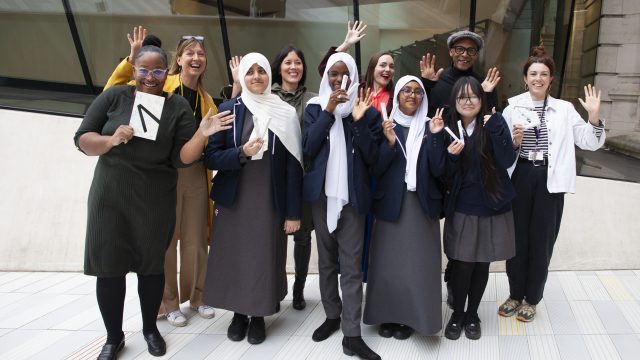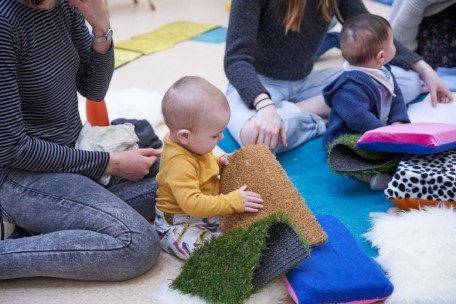I tend to find that textiles, especially liturgical vestments like this chasuble, don’t initially spark an excited response from viewers – which is a pity, as they’re well worth taking the time to look at. Perhaps one reason textiles don’t get a good press is that relatively few from this period survive, and those that do are often fragmentary or much faded. One of the remarkable things about this piece is that although it was altered slightly in the seventeenth century, it is in very good condition for a textile that is six hundred years old.

Chasuble, Italy and England, c.1400-1430, Medieval and Renaissance Galleries, Room 10, Museum No: T.256 to B-1967, ©Victoria and Albert Museum, London
A chasuble was worn by the priest celebrating mass. Along with silver and gilt vessels, altarpieces, illuminated books, costly wax candles, incense and music, vestments played a part in the drama of the liturgy and were additionally a means of honouring God and displaying wealth. Fabulous sums of money were spent on equipping churches and chapels with sets of vestments. A chasuble such as this, made of splendid Italian silk and lavishly embroidered, would have cost as much as a marble tomb, and much more than a painted altarpiece. They were often part of endowments made by private patrons, and one of the interesting things about this particular vestment is that we know who commissioned it. Embroidered on the back are two shields bearing the personal devices of the Lancastrian nobleman Sir Thomas Erpingham (c.1375-1428), a close associate of Henry IV and Henry V, who presumably commissioned it for the use of his personal chaplain, or a church with which he was connected.

©Victoria and Albert Museum, London
The red brocaded silk is woven with an elaborate motif of camels in gold thread, with lilies sprouting from panniers on their backs, and other foliage in between. It will have been woven in Italy, either in Lucca or Venice, the centres of luxury silk production around 1400. Such textiles were eye-wateringly expensive, their designs often produced to order, used not only for liturgical vestments but for princely garments and hangings. Because of their preciousness, pieces of silk were economically used: the front of this chasuble was put together from several pieces. The orphreys (the embroidered decorative bands on front and back) were produced in England, using silk and metallic thread. This type of pictorial embroidery, known as ‘Opus Anglicanum’– literally ‘English work’ – was, like Italian silk, highly prized throughout Europe. The V&A, incidentally, has the best collection of Opus Anglicanum embroidery in the world, much of it on display in Galleries 9 and 10. These particular orphreys depict the Crucifixion and pairs of saints.
In this period mass was celebrated by the priest standing in front of the altar, with his back to the congregation. Consequently it is the back of the garment that is the most beautiful, as it was the most visible. Greater care has been taken align the pattern of the textile on the back than on the front, and the orphrey on the back is the most elaborate, with the scene of the Crucifixion, with the Virgin at the base of the cross, and God above. And significantly, it’s on the back that the patron’s arms appear.

©Victoria and Albert Museum, London
It’s important to imagine what artefacts like this would have looked like when they were in use, rather than displayed statically in a museum case, under museum lighting. The gold threads shimmering as the priest moved, catching the light from candles, would have contributed to a breathtakingly beautiful, and in the context of the mass, literally awesome, effect.



I have been fortunate to find and see the chasubles and maniples in the reserve collection donated by one Alice Hedley in 1902. These are nos 4043-6 V&A 795 1902 and are in remarkable condition.
Another was taken from the mediaeval display & was shown in the recent embroidery exhibition. There is an unconfirmed Hexham/Northumberland, possibly secret, Catholic connection.
Thank you for a fascinating course!
Tom